► What’s next for Lexus?
► Why the brand will benefit from electric technology
► Why the V8-powered LC is an unlikely clue
Ask anyone about Lexus, and you’ll usually end up with the two answers. Most mention the Lexus LFA – the V10-powered tech showcase that’s, to my ears still the best-sounding road car ever made. The other common answer? A midsize, SUV-shaped shrug.
It’s fair to say the Lexus brand is often hard to understand, and sometimes not the most engaging. But there’s one car that harnesses what Lexus really ought to be about and summarises the best of the brand – something even more crucial as it looks to spearhead Toyota’s move into the electric space.
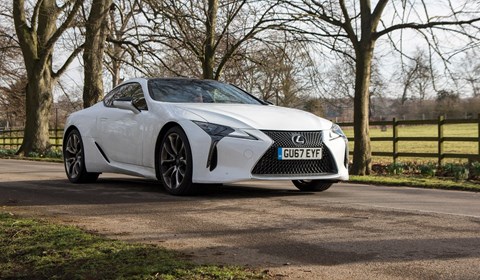
I’m talking about the Lexus LC500 (above), a curious coupe that doesn’t seem to make sense in brand’s range of safe crossovers and saloons – but one that makes so much sense once you go for a drive. For the last three months I’ve been using Lexus’ unlikely flagship (in V8, not hybrid form) as my main form of transport, and it’s made me look forward to the brand’s EV-focused future.
It sort of looks like a Lexus…
On the surface it’s everything you’d expect from an aggressive, sporty Lexus. The spindle grille is still there at the front, but here it’s a launching point for smoother, more flowing lines than any other car in the range. Wide and low and with strong haunches that jut out from the front, the LC looks powerful before you push the start button – but look closer and you’ll find additional bits of design that set this apart from your RXs and RZs: although they follow the same spiky, ‘more than, less than’ look of other Lexus cars, the headlights on the LC500 are dripping with extra details. It’s the same story at the rear two, where mirrored rear lights seem to reflect into infinity.
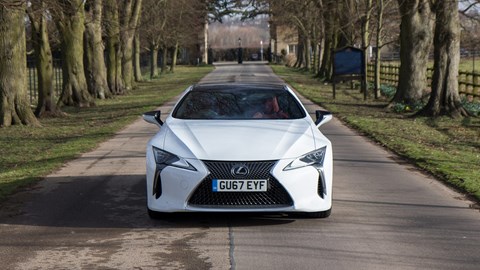
Inside, it’s clear the LC is pointed toward a particular demographic. When you open the door, the seats do their best to cradle you and then lower you to its dynamic driving position. Look around the cabin, and you’ll see a traditional clock and a CD player. Yup, despite being launched in 2017, the Lexus LC is one of the few cars on sale to come with CD player – albeit paired to a high-performance Mark Levinson sound solution. The infotainment system, which uses the touchpad system already replaced in more recent models is here, too. Still, so far so civilised.
That is until you fire the thing up. As the V8 rumbles into life, this car quickly descends into a muscle car in an executive suit. Think of it as a UFC fighter in a Saville Row suit and you’re pretty much there. No matter how gently you treat the accelerator, there’s too much torque for the rear wheels: every launch is accompanied by the perpetual blinking of the traction control light, and a few revs later, the guttural roar of the V8 up front. It may look elegant when static, but the LC is a riot in motion.
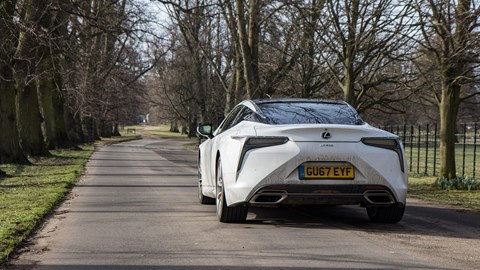
At two tonnes it’s heavier and wider than the Alfa Romeo Tonale I’m currently running – and that means it needs to be treated with care on corner entry. Still, on exits you get to feed that power in – and feel the rear of the car give up once again. Once you get used to the size and the dynamic limitations of the Lexus, it becomes second nature – but never boring. This is a fun car to push in, not a precise tool – but something more akin to a Toyota GR86 in a heavyweight class. Slower, less agile but with one hell of a punch.
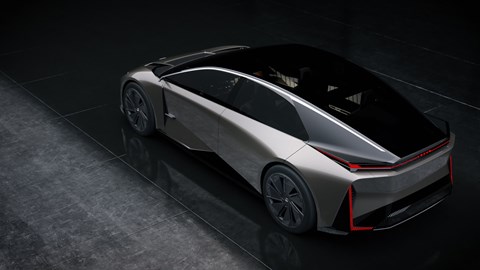
Moving to electric
But what does this have to do with the Lexus cars of the future? Well, everything. Low, wide and heavy with bundles of torque is great way to describe this oddball Lexus – but also every single sports-focused EV we’ve ever driven. The LC 500 is proof that Lexus can make great, powerful GT cars – with a vein of lunacy we’ve seen in its sister brand’s GR models. Take out the V8 (if we must) and replace it with around 800bhp of electric power and even more torque, and you’d have one of the most interesting – and best-looking – EVs on the market.
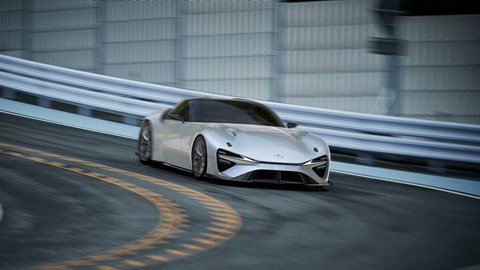
How likely is all of this?
Lexus’ EV push is already in motion and an electric supercar (above) is already on the drawing board. The brand has been on an electric supercar, first shown late in 2021, and one of sixteen BEVs. Lexus says it’ll be reviving the spirit of the iconic V10-powered LFA, with a brand is aiming for a range of 430 miles, as well as a two-second 0-62mph launch. If Lexus can get that flagship right, and all the slower, more usable cars below it – it’ll solidify what we think of the badge.
Yes, we’ll miss the theatre of the V8 – but solid-state battery tech and steer-by-wire technology – and all the benefits to driving engagement the latter could bring – beckoning, the LC may represent a beginning as well as an end.